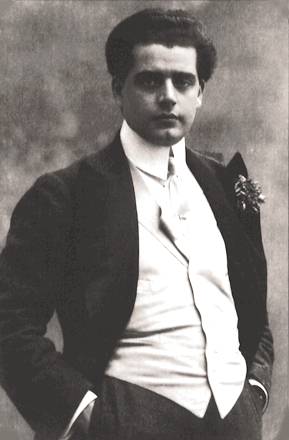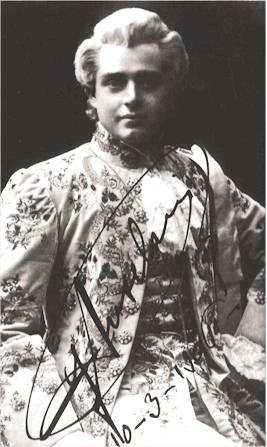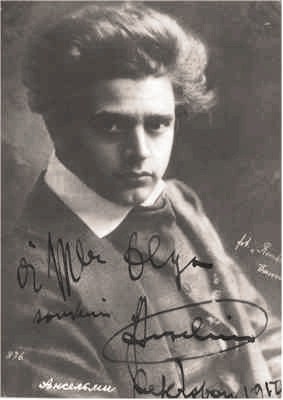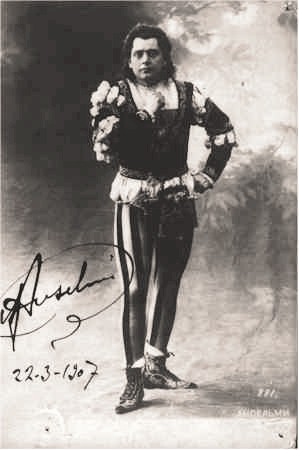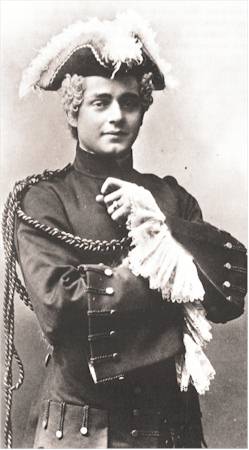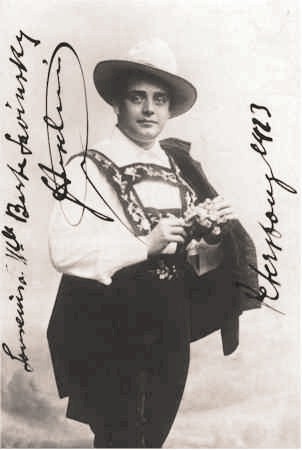Italian tenor, 1876 - 1929
Biographical notes:
He was born Antonio Giuseppe Anselmi in Nicolosi, near Catania, and entered the Naples Conservatory when he was only 12 years old. There he studied composition, violin and piano
before he became interested in singing. Exactly when Anselmi turned his attention to voice, or whether he studied with someone or was primarily self-taught, is not clear, but he is generally
credited with touring in an operetta company by the time he was only 16 years old. At one point in his travels, he was heard by Giulio Ricordi, who sensed operatic possibilities and referred the
young man to Luigi Mancinelli for further vocal training. Anselmi is generally credited by the "authoritative" sources as having made his operatic debut at the Royal Opera in Athens (1896), as Turiddu in
Cavalleria Rusticana, but there is no surviving documentation to support this claim. In a 1918 interview, Anselmi remembered the year as being a bit later, and the location being
Patras, Greece, where his repertoire did include Turiddu, but the tenor roles in La Traviata, Rigoletto and Il Barbiere di Siviglia as well. In late 1898, Anselmi appeared at Smyrna with an
opera company headed by an impressario named Gonzalez, and toured with the company to Athens, Istanbul and Alexandria. As a principal tenor with this company, he sometimes sang as many as five times a week.
As Des Grieux in “Manon”
In 1900, Anselmi made his debut in Genoa, singing Rodolfo, the Duke and Edgardo (to Fanny Toresella’s Lucia). That same year he appeared at the San Carlo in Naples, where he sang with Angelica Pandolfini and Rina Giachetti (the sister of Caruso’s mistress) in Le Maschere, a new work by Mascagni. Anselmi made his London debut at Covent Garden (1901) as the Duke in Rigoletto (with Suzanne Adams as Gilda). His other performances that summer in London included Rodolfo (with Melba and Scotti) and the tenor solo in Verdi’s Messa da Requiem (with Gadski, Brema and Plançon). The London critics were for the most part unimpressed, and spoke of "bad habits" and a "disagreeable bleating tone that is characteristic of Italian tenors." The Times critic predicted that Anselmi’s voice would be "permanently ruined" within a "few seasons." Then, as now, critics were frequently incorrect.
(courtesy of Charles B. Mintzer)
He returned to London on several occasions, but was especially admired in St. Petersburg, Buenos Aires, Milan (La Scala), Warsaw and Madrid in a variety of rôles that included Cavaradossi, Loris in Fedora
, Maurizio in Adriana Lecouvreur, Osaka in Iris, Lensky, Edgardo, Nadir in Pescatori di Perle and many others. He also sang with great success in opera and
concerts in Brussels, Vienna, Berlin, Monte Carlo and Paris (although his only known performance there took place in 1907 in the private theater of Jean de Reszke’s home; he sang Almalviva to
Adelina Patti’s Rosina in her last ever operatic appearance). The First World War greatly curtailed his activities, and by the time it was over, so was, for the
most part, Anselmi’s relatively short career. Like a great many other famous singers of his era, he turned to teaching (in Italy), and also did some composing of his own. His last appearance was at
a benefit concert in Rapallo (1926), when he not only sang, but played the violin and provided the piano accompaniment for some of his students as well. Pneumonia claimed him at a rather early age.
As Roméo in “Roméo et Juliette”
(courtesy of Charles B. Mintzer) Comments: Giuseppe Anselmi, a fine actor, was tall and handsome as well, and became very much a "matinée
idol" in his day, more or less in the tradition of Jean de Reszke. But good looks in his case were merely an eye-pleasing ornamentation, for he possessed an equally lovely voice and was very
musically intelligent. There are many aspects to his personal life that were shrouded in mystery even during his lifetime; he seems to have liked it that way. Anselmi was passionately devoted to
his art, and in the end gave his heart to Madrid (quite literally), where it is preserved in that city’s theatrical museum.
As Maurizio in “Adriana Lecouvreur” Recordings:
The records are abundant (he made nearly 150) and speak for themselves so far as Anselmi’s vocal powers and musical intelligence are concerned. After listening to only a few, one senses
that his sole concern in their making was the artistic presentation of the music he sang, as opposed to the glorification of his own voice. He recorded prolifically for Fonotipia and made a
number of discs for Edison. The latter are all included on Marston’s "Three Edison Tenors," the other two featured artists being Alessandro Bonci and José Mojica. He is also well represented in opera and song on
Symposium’s "Harold Wayne Collection – Volume 20," and Enterprise’s
"Vocal Archives" series, which issued a CD including over twenty of Anselmi’s recordings.
As Nemorino in “L’Elisir d’amore” (courtesy of Charles B. Mintzer)
His records may be an "acquired" taste for those who judge all tenors of his era based on
Caruso. Anselmi was the more refined artist, vocally, with much grace and subtle beauty to be heard on many of his finest discs. There are trills delivered with a coloratura skill that must
have been the envy of many a soprano, and high C’s enough to satisfy the multitudes who base their evaluation of a tenor’s talents on this one magical note. His voice on record, of course, is
not without flaw; occasionally there are deviations from pitch in seemingly unlikely, undemanding places, and the lowest tones sometimes have a slightly guttural edge. More
frequently, he has a tendency to clear his throat for all to hear. He does this no less than three times in the piano introduction for "Amor ti vieta" from Fedora,
yet somehow this doesn’t matter since it is one of the finest, most heartfelt interpretations of the aria on record. In "Che gelida manina" from La Bohème, he tenderly renders the love song
Puccini intended, with well-measured dramatic intensity added only as needed – but the most sustained passages occasionally take his breath away. Anselmi’s very careful attention to
phrasing makes an undistinguished aria from Paderewski’s Manru sound like interesting music, when in fact, it’s anything but interesting; perhaps here is the best example of his genius. Time
and again, both in songs and operatic excerpts from Don Pasquale, La Gioconda, Pagliacci, Luisa Miller, Manon Lescaut and many others, Anselmi proves why he is so highly regarded to this day
by collectors of fine historical recordings.
My warmest thanks to George Parous and Charles B. Mintzer
|
|||||||||||||||||||||||||||||||||||
